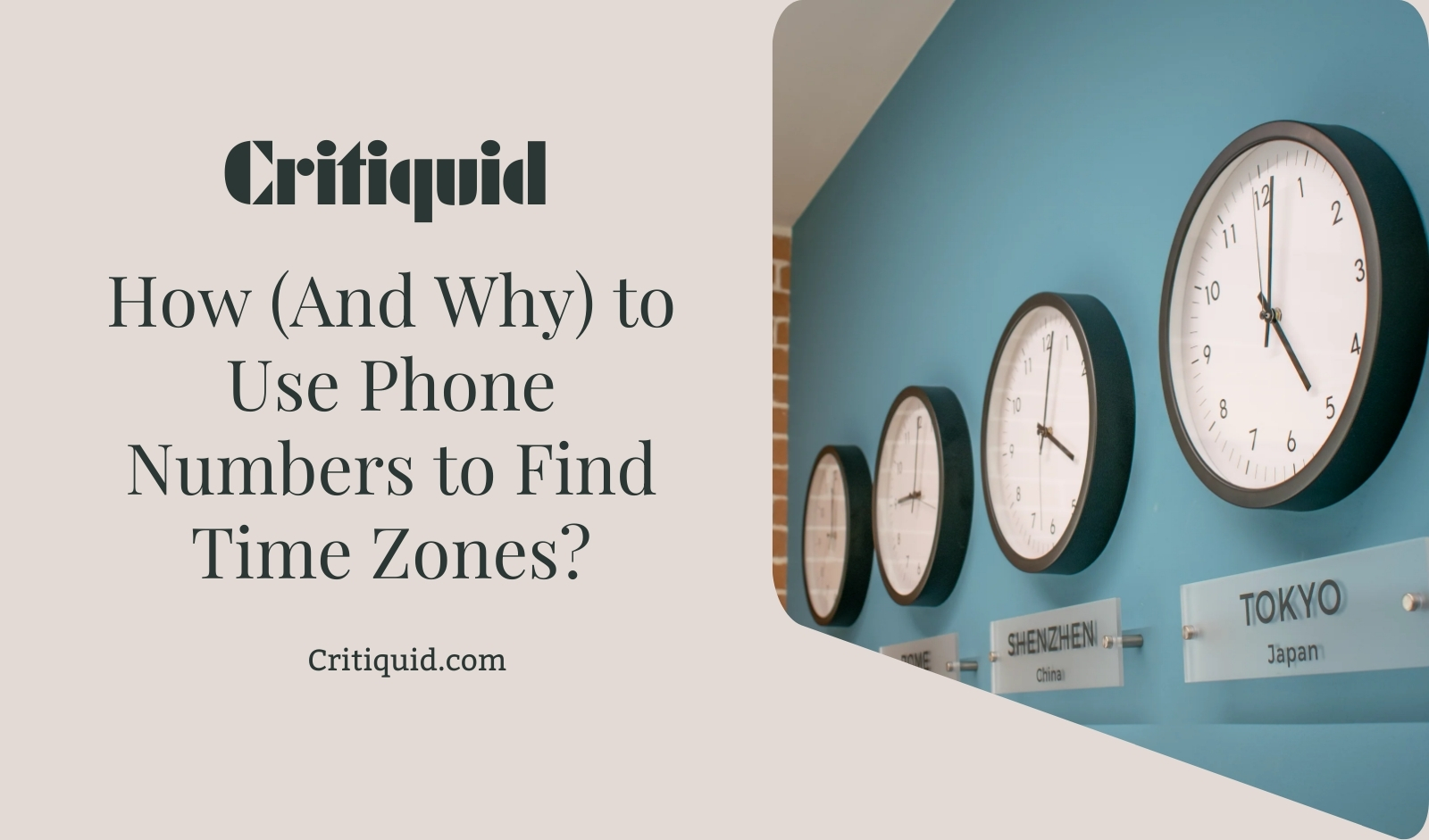How (And Why) to Use Phone Numbers to Find Time Zones?

In today’s globally connected world, knowing when to call someone in a different region can be the difference between closing a deal and missing an opportunity. Let us begin exploring a surprisingly useful skill that many professionals overlook: determining time zones from phone numbers.
The Challenge of Global Communication
Have you ever accidentally called someone at 3 a.m. their time? Or missed an important international meeting because of time zone confusion? You’re not alone.
For business professionals, remote workers, and anyone with international connections, navigating time zones remains a persistent challenge. While calendar apps and scheduling tools help, understanding how to quickly identify someone’s likely time zone from their phone number provides an immediate advantage.
Understanding International Phone Numbers
Before diving into time zone identification, it’s important to understand how international phone numbers are structured.
A typical international phone number contains:
- Country code (1-3 digits)
- Area/city code (1-4 digits)
- Local number (typically 7-8 digits)
The country code is your key to time zone identification. This numeric prefix (like +1 for North America or +44 for the United Kingdom) instantly narrows down geographical location.
Why Use Phone Numbers for Time Zone Detection?
You might wonder why you should bother learning this skill when you could simply ask someone their local time or use a time zone app. Here’s why this knowledge matters:
- Immediate information – No need to wait for a response when planning communication
- Professional courtesy – Shows respect for others’ time without requiring them to provide additional details
- Scheduling efficiency – Allows for faster decision-making when coordinating across regions
- Reduced errors – Minimizes the risk of miscalculation when planning international calls
- Emergency situations – Particularly valuable when immediate contact is necessary but you need to know if it’s an appropriate time
Common Country Codes and Their Time Zones
Let’s examine some frequently encountered country codes and their corresponding time zones:
North America (+1) The +1 country code encompasses the United States, Canada, and some Caribbean nations, spanning multiple time zones:
- Eastern Time (UTC-5/4): New York, Toronto, Miami
- Central Time (UTC-6/5): Chicago, Dallas, Mexico City
- Mountain Time (UTC-7/6): Denver, Calgary
- Pacific Time (UTC-8/7): Los Angeles, Vancouver
- Alaska Time (UTC-9/8): Anchorage
- Hawaii-Aleutian Time (UTC-10/9): Honolulu
United Kingdom (+44) The UK operates on Greenwich Mean Time (GMT/UTC+0) during winter and British Summer Time (BST/UTC+1) during summer months.
Australia (+61) Australia spans multiple time zones:
- Eastern Australia (UTC+10/11): Sydney, Melbourne
- Central Australia (UTC+9:30/10:30): Adelaide
- Western Australia (UTC+8): Perth
India (+91) India operates on a single time zone (UTC+5:30) nationwide.
European Union Europe utilizes various country codes with time zones generally ranging from UTC+1 to UTC+3:
- France, Germany, Italy, Spain (+33, +49, +39, +34): UTC+1/2
- Finland, Greece (+358, +30): UTC+2/3
How to Determine Time Zones from Phone Numbers
Let’s break down the process into simple steps:
- Identify the country code – Look for the initial digits after the plus sign
- Research the country’s time zone(s) – Some countries span multiple time zones
- Consider area codes for large countries – In countries like the US, Russia, or Australia, area codes provide more specific location information
- Account for Daylight Saving Time – Remember that many regions adjust their clocks seasonally
Example 1: Decoding a US Phone Number
If you see the number +1 (212) 555-1234:
- +1 indicates North America
- Area code 212 is Manhattan, New York
- New York is in Eastern Time (UTC-5, or UTC-4 during Daylight Saving Time)
Example 2: Analyzing an International Number
For +61 3 9555 1234:
- +61 reveals this is an Australian number
- The digit 3 indicates Victoria/Melbourne
- Melbourne uses Australian Eastern Standard Time (UTC+10, or UTC+11 during summer)
Tools and Resources to Help
While understanding the basic principles is valuable, several tools can assist with time zone identification:
- Phone number lookup services – Websites like Truecaller or NumberingPlans.com provide location information for phone numbers
- Time zone converters – TimeandDate.com and WorldTimeBuddy allow you to compare multiple time zones
- Mobile apps – Apps like World Clock, Time Buddy, or Miranda offer on-the-go time zone conversion
- CRM systems – Many customer relationship management tools automatically tag contacts with their time zones
- Google Search – Simply searching “what time is it in [location]” provides instant information
Common Challenges and Solutions
Identifying time zones from phone numbers isn’t always straightforward. Here are some challenges you might encounter:
Multiple Time Zones Within Countries Large countries often span several time zones. The United States covers six standard time zones, while Russia spans an incredible 11 time zones.
Solution: For these countries, use area codes to narrow down the specific region. For example, a +1 phone number with area code 415 indicates San Francisco (Pacific Time), while area code 212 points to New York (Eastern Time).
Mobile Number Portability With modern telecommunications, people can keep their phone numbers when moving to new locations.
Solution: While the number might suggest one location, always verify time zones for important calls, especially with contacts you know have relocated.
VoIP and International Services Voice over Internet Protocol (VoIP) services and international business numbers may not correspond to physical locations.
Solution: For business contacts using these services, rely on company information rather than phone numbers alone for time zone identification.
Daylight Saving Time Variations Countries start and end Daylight Saving Time on different dates, adding another layer of complexity.
Solution: Use up-to-date time zone converters that account for these seasonal changes.
Best Practices for International Communication
Knowing the time zone is just the first step. Here are some best practices for effective global communication:
- Schedule buffer time – Allow 15-30 minutes of buffer when scheduling meetings across time zones
- Confirm availability – Even after determining someone’s likely time zone, confirm their availability before scheduling important calls
- Use 24-hour format – To avoid AM/PM confusion, use the 24-hour format when scheduling international meetings
- Include multiple time zones – When sending meeting invitations, include the time in all relevant time zones
- Be mindful of weekends – Remember that weekends fall on different days in some countries (e.g., Friday-Saturday in many Middle Eastern countries)
- Consider cultural differences – Business hours vary globally; what’s considered “end of day” differs across cultures
Real-World Applications
Let’s explore some practical scenarios where identifying time zones from phone numbers proves valuable:
Business Development
If you’re a sales professional with leads across multiple countries, quickly determining appropriate calling hours can improve your connection rates significantly. Rather than navigating through complex scheduling tools, a glance at the country code gives you immediate guidance on the best time to reach out.
Remote Team Management
For team leaders managing global workforces, understanding the time zones of team members based on their contact information helps in scheduling inclusive meetings and respecting work-life boundaries.
Emergency Response
In crisis situations, knowing whether it’s the middle of the night or business hours in someone’s location can guide appropriate response strategies. This is particularly relevant for global security teams, international health services, and disaster response organizations.
Customer Service
For businesses offering 24/7 support, routing calls to the appropriate service centers based on the caller’s likely time zone improves efficiency and customer satisfaction.
Creating a Time Zone Reference Guide
For professionals who frequently communicate across borders, creating a personalized time zone reference guide can be immensely helpful. Here’s how:
- List key country codes relevant to your work
- Note the time zone(s) for each country
- Include common area codes for large countries
- Add seasonal time changes where applicable
- Calculate typical working hours in your time zone
This reference guide becomes especially valuable for teams working with specific international markets, allowing for quicker decision-making without constantly checking time zone converters.
The Future of Time Zone Management
As global communication continues to evolve, new tools are emerging to simplify time zone management:
- AI-powered scheduling assistants that automatically detect optimal meeting times across time zones
- Smart notification systems that adjust delivery based on recipients’ time zones
- Collaborative platforms with built-in time zone awareness
- Global presence indicators showing real-time availability of contacts
Despite these technological advances, understanding the fundamental connection between phone numbers and time zones remains a valuable skill that enhances professional communication.
Beyond Business: Personal Applications
This skill extends beyond professional contexts. When planning:
- Calls with distant family members
- Online gaming sessions with international friends
- Virtual social gatherings
- Coordination with vacation properties or tour guides abroad
Knowing how to determine time zones from phone numbers helps ensure these personal connections happen at convenient times for all parties.
Summary: Mastering the Time Zone Advantage
Understanding how to identify time zones from phone numbers gives you a distinct advantage in our globally connected world. This skill:
- Demonstrates respect for others’ time
- Improves communication efficiency
- Reduces scheduling errors
- Enhances professional relationships
- Provides immediate geographical context
Like learning to read a map in the age of GPS, this knowledge offers both practical utility and deeper understanding of our interconnected world. Whether you’re closing international deals, managing remote teams, or simply staying connected with friends abroad, the ability to decode time zones from phone numbers is a surprisingly valuable addition to your professional toolkit.
Next time you see an international phone number, take a moment to consider what it tells you about the person’s location and time zone. This small insight might just make the difference between a perfectly timed connection and a missed opportunity.






